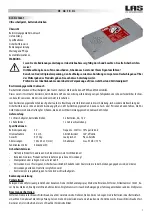
12
3 R 74 en
a two-piece cone-shaped bushing, which is tightened
firmly with a tightening screw (I) around the valve shaft.
❑
Mount the bushing and the tightening screw from
the mounting interface side of the actuator,
according to Fig. 31. Insert cylindrical pins (III) in
the bushing slots, these must be directed into the
corresponding slots in the actuator during tight-
ening. Before the installation of the bushing and
the tightening screw, remove impurities such as
old threadlocking material from the threads of the
tightening screw, and apply Loctite 225 or similar
threadlock carefully to the threads, as shown in
Fig. 31. Turn the tightening screw from inside the
actuator shaft using a suitable hex key, Fig. 32.
❑
Prior to installation, the correct keyway position of
the valve has to be checked. The bushing has four
keyways, two of which are intended for valves with
DIN key and two for valve shafts with ANSI key. The
ANSI keyway is located in the middle of the half
bushing, and the DIN keyway is located in the split
between the bushing halves. Fig. 33 shows the key-
way position when the actuator is in a closed posi-
tion.
❑
The open or closed positions of the actuator can
be identified either by using compressed air, see
Fig. 34, or by checking the position of the pointer
at the end of the drive shaft. The actuator is closed
if the pointer on the coupling plate is transverse to
the direction of the actuator’s main shaft.
❑
Mount the actuator either directly on the valve, or
attach it to the valve bracket with four screws.
The tightening screw of the bushing should be
loosened before mounting, to allow the shaft to fit
easily into the actuator.
❑
The actuator construction allows axial movement
of the drive shaft. Check, before the screw is tight-
ened, that the drive shaft is in the upper position of
its axial movement, which is its normal position
(the mounting position shown in Fig. 32). Check-
ing is important, as the actuator shaft drops down
slightly when the screw is tightened. The drive
shaft axial movement can be observed and meas-
ured before attachment to a valve. The actuator
drive shaft is in the upper position when its upper
surface conforms to Table 5, see also Fig. 32.
❑
The drive shaft will automatically find its correct
position if the installation tool H061904 (see Fig.
32) is used. The installation tool is attached
instead of the coupling plate using M4 screws
Fig. 31
Cone bushing installation
Fig. 32
Tightening of the cone bushing
Loctite 225
or similar
Key
X
Installation tool
H061904
Fig. 33
Keyway positions on the actuator
Fig. 34
Actuator connections
Table
5
Mounting faces, tightening screws and
drive shaft clearances
Size
Moun
t.
Threa
d
Key
Nm
~X
upper pos.
(mm)
~X
lower pos.
(mm)
EC/EJ05
EC/EJ07
EC/EJ10
EC/EJ12
EC/EJ14
F05
F07
F10
F12
F14
M12
M16
M20
M24
M36
6
8
10
14
19
25
50
100
200
700
4.0
1.5
2.5
3.5
4.5
1
-2
-2
-2
-2
ANSI keyways in the
middle of bushing
DIN keyways at
bushing split
ACTUATOR IN
CLOSED POSITION
Adjustment screw
for closed position
Closing pressure
Opening
pressure
Adjustment screw
for open position













































